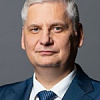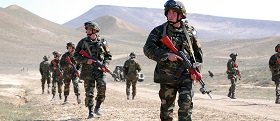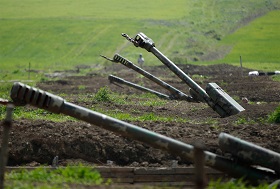The conflict around Nagorno-Karabakh was one of the first of its kind in the former USSR. Over the past quarter of a century, it has transformed from an intercommunal and inter-republic conflict within a single state (the USSR) into a protracted confrontation between Armenia and Azerbaijan with the prospects for resolution being unclear. Russia (the successor to the USSR) has expressed an interest in settling this confrontation, as have neighbouring Turkey and Iran, and a number of external actors, namely the United States and the European Union.
The conflict around Nagorno-Karabakh was one of the first of its kind in the former USSR. Over the past quarter of a century, it has transformed from an intercommunal and inter-republic conflict within a single state (the USSR) into a protracted confrontation between Armenia and Azerbaijan with the prospects for resolution being unclear [1]. Russia (the successor to the USSR) has expressed an interest in settling this confrontation, as have neighbouring Turkey and Iran, and a number of external actors, namely the United States and the European Union.
In May 1994, when the Open-Ended Ceasefire Agreement came into force, it marked the next stage of the conflict, which could be defined as “a dynamic status quo.” Consequently, open military hostilities ceased and the parties began searching for means of a peaceful resolution. Unlike other hotbeds of unrest in the post-Soviet space, peacekeepers were never present in Nagorno-Karabakh and the neighbouring territories. The line of contact (about 200 kilometres) is maintained due to the military and political balance of power. The ceasefire is constantly breached [2], with the most significant breach since May 1994 occurring in April 2016. However, despite those shocks, the status quo has been preserved. The line of contact has not drastically changed (Azerbaijan took control of very little ground), the unrecognized Nagorno-Karabakh Republic preserved its infrastructure, the negotiation process continued both under the auspices of the OSCE Minsk Group [3] and as three-party talks (Russia – Armenia – Azerbaijan). At the same time, after the events of April, the de-escalation of the military confrontation did not put an end to incidents along the line of contact.
An Atypical Consensus between Russia and the West
Unlike in the conflicts in Abkhazia, South Ossetia, Transnistria, the southeast of Ukraine, and the Balkans, the stances adopted by Russia and the West on the Nagorno-Karabakh confrontation are virtually identical [4]. Today, the three countries that co-chair the Minsk Group (the United States, Russia and France) retain the consensus acknowledging the revised “Madrid principles” as the basis for a peaceful resolution of the situation, despite all the existing differences [5].
Russia’s role in the Nagorno-Karabakh process is fundamentally different from its role in Transcaucasia. First, both parties to the conflict view Russia as a desired intermediary (that was not the case in either Abkhazia or South Ossetia, at least during the early 2000s) [6]. Both Baku and Yerevan are interested in developing bilateral relations with Moscow outside the Nagorno-Karabakh settlement. Azerbaijan and Russia are brought together by their common border in Dagestan and by a series of threats, such as the spread of radical Islamism. Baku and Moscow also cooperate on a wide range of issues in the Caspian region. Armenia is a member of the Collective Security Treaty Organization (CSTO) and Moscow’s only military ally in Transcaucasia. Armenia is home to the 102nd Military Base of the Group of Russian Forces in Transcaucasia, as well as to border guards who secure the external perimeter of the Republic’s state border. At the same time, the Kremlin has high-level confidence-based relations with both the Armenian and Azerbaijani elites.
Second, the West supports Russia’s peace-making activities in Nagorno-Karabakh. Even today, with relations between Moscow and Washington at their lowest point since the collapse of the USSR, American diplomats positively assess the role that the Russian leadership played in de-escalating the military confrontation and in vitalizing the three-party talks.
The Karabakh settlement remains virtually the only relatively successful format of interaction between the United States and Russia in the post-Soviet space. Washington balances between various interest groups, as is also the case with Moscow. As for the European Union, Brussels has no independent peace-making projects with regard to Nagorno-Karabakh. France is the European Union’s representative in the Minsk Group.
The Neighbour Factor: Turkey and Iran
Russia and the West are far from being the only actors with regard to Nagorno-Karabakh. It is impossible to achieve a settlement of the ethno-political conflict between Armenia and Azerbaijan without taking into account the interests of neighbouring powers, Turkey and Iran, both of which claim the role of independent actors with interests different from those of Moscow and Washington. At the same time, Ankara and Tehran offer different participation models for resolving the confrontation. While Turkey has taken Azerbaijan’s side [6], Iran attempts to act as an intermediary balancing between Yerevan and Baku [7]. In this context, Turkey’s stance as a NATO country is significantly different from that of its NATO allies, the United States and France, which advocate a compromise solution, and not a victory for one party.
At the same time, we should note that in 2008–2010, when Turkey and Armenia attempted to normalize bilateral relations, the two countries announced their intention to separate the Nagorno-Karabakh conflict from the general political and historical context of their bilateral relations; however, this goal was never achieved [8].
Iran has assumed two positions with regard to Nagorno-Karabakh. The first position is that the conflict should be resolved peacefully and primarily through the efforts of the countries in the region. The second is Iran’s critical attitude to implementing the revised “Madrid principles.” Iran is not satisfied with such a resolution of the Nagorno-Karabakh conflict, which would entail deploying international peacekeepers to the region (it does not matter under whose colours the peacekeepers would act). Tehran’s representatives have always claimed that there should be no external actors in the region. As regards the “basic principles” of a settlement, Iran’s stance does not coincide with Russia’s, although, like Russia, Iran is against a military resolution. Paradoxically, that brings Iran’s stance closer to that of the two “Western” co-chairs of the OSCE’s Minsk Group.
Any Solution is Possible, Except Military Confrontation
However, any kind of negotiation with the participation of “interested parties” (be it Russia, the United States, Turkey, or Iran) is unlikely to produce positive results if the parties to the conflict fail to find compromise formulas that could be implemented in practice. Yerevan and Baku are not ready for compromises. By “conflict settlement,” each party to the conflict understands it as victory over the enemy, not as concessions and taking steps to meet each other halfway. For one party, it means solidifying the military political success achieved in May 1994; for the other, it means restoring its territorial integrity by using, among other things, military methods similar to those employed Croatia in its operations against the self-proclaimed Republic of Serbian Krajina. Most likely, negotiations should not have a predetermined outcome. By default, simply restoring disputed territories to the state to which they are formally “assigned” is impossible. At the same time, it is dangerous to provoke the process of unilateral ethnic self-determination of the Nagorno-Karabakh Republic, especially without taking into account the situation in those parts of the Republic that had not been parts of the Nagorno-Karabakh Autonomous Region previously, and had not pushed for secession from Azerbaijan.
The specific resolution to the conflict should come as a concluding outcome of a series of agreements and even political bargaining. In this regard, complete exclusion of the use of force from the settlement process should be prioritized. The “any solution is possible, except military confrontation” formula should form the crux of the negotiations.
1. After three years of military hostilities (1991–1994), Armenian forces gained control over almost the entire territory of the former Nagorno-Karabakh Autonomous Region, save for a few small territories in the Martuni and Mardakert districts. Five districts outside the Autonomous Region fell under complete Armenian control, and two outside districts fell under partial Armenian control, as did Azerbaijani enclaves in Armenia (three villages). The Azerbaijani military took control of the Artsvashen enclave (which had been a part of the Armenian Soviet Socialist Republic). Today, 13.62 per of Azerbaijan’s territory (as recognized by the UN) is not under Baku’s control.
For more information, see: Kazimirov V.N. Peace to Karabakh. Russia as an Intermediary in Settling the Nagorno-Karabakh Conflict Мoscow, Mezhdunarodnye otnosheniia, 2009.
2. On November 12, 2014, Azerbaijan’s military shot down Armenia’s Mi-24 military helicopter (three crew members died). On the night of December 8 to December 9, 2015, tanks were used along the line of contact. On the night of April 1 to April 2, 2016, military clashes occurred along the entire length of the line of contact. On April 5, the chiefs of staff of Armenia and Azerbaijan signed a ceasefire agreement in Moscow.
3. The Minsk Group (MG) is a negotiation format under the auspices of the OSCE. The Group’s first meeting took place on June 1, 1992 in Rome. Presently, the OSCE’s MG has three co-chairs (Russia, the United States and France).
4. The Denver joint statement of June 23, 1997, became the first in a series of joint statements by the Presidents of the United States, Russia, and France.
5. On July 10, 2009, the Presidents of Russia, the United States, and France made a joint statement on the settlement of the conflict.
6. Two exclusive interviews given by President of Azerbaijan Ilkham Aliev and President of Armenia Serzh Sargsyan to RIA Novosti are telling in that regard. Both presidents expressed a high opinion of Russia’s activity on the settlement of the Nagorno-Karabakh conflict.
7. In April 1993, Turkey closed its land border with Armenia (a little over 300 kilometres). Currently, the border remains closed.
8. In 1992, at the initiative of Tehran, then presidents Akbar Hashemi Rafsanjani, Levon Ter-Petrosyan, and Azerbaijan’s acting head of state Yagub Mamedov signed the Tehran Communiqué. However, subsequent military escalation virtually nullified that step. For the Statement’s full text, see: Joint Statement of Heads of State in Tehran. URL: http://vn.kazimirov.ru/doc3.htm







